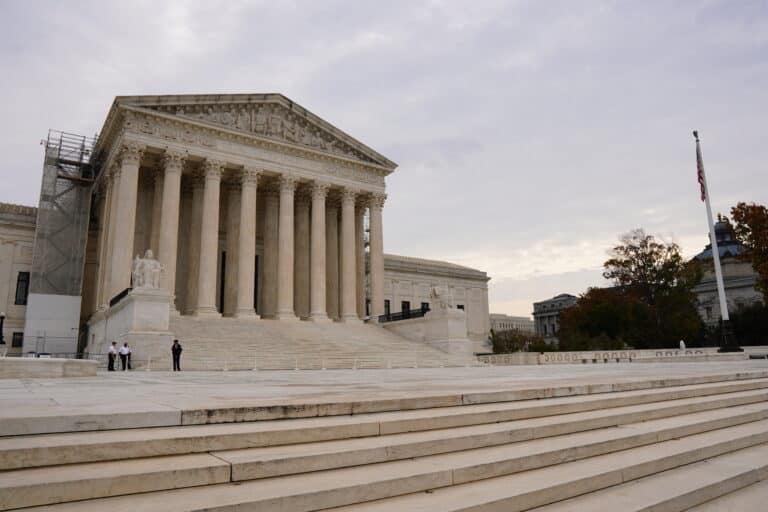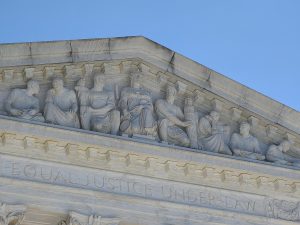Is the Supreme Court already retreating from its recently adopted Second Amendment legal test? The chief architect of that test seems to think so.
A nearly unanimous Court upheld the federal gun ban for persons subject to domestic violence restraining orders last week in U.S. v. Rahimi. The majority did so after finding that the law fit within the nation’s history and tradition of firearms regulation, the key bar modern regulations must clear to pass constitutional muster under the Bruen standard of review.
“Since the founding, our Nation’s firearm laws have included provisions preventing individuals who threaten physical harm to others from misusing firearms,” Chief Justice John Roberts wrote on behalf of the eight-member majority. “As applied to the facts of this case, Section 922(g)(8) fits comfortably within this tradition.”
Notably, Justice Clarence Thomas broke with his five fellow conservatives as well as the Court’s liberals to register his disagreement. Thomas argued that the Court’s majority failed to adhere to the same Bruen standard many signed on to just two years prior.
“After New York State Rifle & Pistol Assn., Inc. v. Bruen, this Court’s directive was clear: A firearm regulation that falls within the Second Amendment’s plain text is unconstitutional unless it is consistent with the Nation’s historical tradition of firearm regulation,” Thomas wrote. “Not a single historical regulation justifies the statute at issue.”
Specifically, Thomas took issue with what he argued was the majority’s loose interpretation of historical analogues to the modern-day gun ban for persons subject to domestic violence restraining orders.
In upholding the law, Roberts and the rest of the Court acknowledged that a “historical twin” for §922(g)(8) did not exist at the time of the Founding. Instead, they argued that two common public safety measures often employed at the time—surety and affray laws — provide evidence of a more generalized principle of disarming threatening individuals.
Surety laws required those suspected by a justice of the peace of being a public danger, including those possessing firearms, to post a bond against breaching the peace. Meanwhile, affray laws criminalized the act of carrying or using weapons to terrify the public and could be enforced with weapon forfeiture and imprisonment.
“Taken together, the surety and going armed laws confirm what common sense suggests: When an individual poses a clear threat of physical violence to another, the threatening individual may be disarmed,” Roberts wrote. “Section 922(g)(8) is by no means identical to these founding era regimes, but it does not need to be.”
Thomas slammed those comparisons for failing to match “how” and “why” such laws burdened arms rights with the modern restriction, a significant instruction he included in his Bruen opinion for future courts.
“Neither is a compelling historical analogue,” he wrote. “As I have explained, surety laws did not impose a burden comparable to §922(g)(8). And, affray laws had a dissimilar burden and justification. The Court does not reckon with these vital differences, asserting that the disagreement is whether surety and affray laws must be an exact copy of §922(g)(8). But, the historical evidence shows that those laws are worlds—not degrees—apart from §922(g)(8).”
Not only did he fault the offered analogues for falling short individually, but he also chastised the majority for picking specific elements of the two legal regimes to craft a workable tradition in a collage-like approach.
“The Court recognizes that surety and affray laws on their own are not enough. So, it takes pieces from each to stitch together an analogue for §922(g)(8),” Thomas wrote. “Our precedents foreclose that approach. The question before us is whether a single historical law has both a comparable burden and justification as §922(g)(8), not whether several laws can be cobbled together to qualify.”
He even went so far as to charge the majority with “defeat[ing] the purpose of a historical inquiry altogether.”
“Given that imprisonment (which involved disarmament) existed at the founding, the Government can always satisfy this newly minted comparable-burden requirement,” Thomas wrote. “That means the Government need only find a historical law with a comparable justification to validate modern disarmament regimes. As a result, historical laws fining certain behavior could justify completely disarming a person for the same behavior. That is the exact sort of ‘regulatory blank check’ that Bruen warns against and the American people ratified the Second Amendment to preclude.”
Some members of the majority directly addressed Thomas’ critiques. Chief Justice Roberts attempted to rebut his claims that the Court’s opinion failed to provide a relevantly similar historical analogue.
“The dissent reaches a contrary conclusion, primarily on the ground that the historical analogues for Section 922(g)(8) are not sufficiently similar to place that provision in our historical tradition,” Chief Justice Roberts wrote. “The dissent does, however, acknowledge that Section 922(g)(8) is within that tradition when it comes to the ‘why’ of the appropriate inquiry. The objection is to the ‘how.’ For the reasons we have set forth, however, we conclude that Section 922(g)(8) satisfies that part of the inquiry as well.”
He reiterated that Section 922(g)(8) restricts gun use to mitigate demonstrated threats of physical violence, matching the “why” of surety and affray laws. He also noted that sureties were temporary restrictions, much like the modern 922(g)(8) prohibition is, and that affray violations were punished with imprisonment, a far more serious “how” than temporary disarmament.
“If imprisonment was permissible to respond to the use of guns to threaten the physical safety of others, then the lesser restriction of temporary disarmament that Section 922(g)(8) imposes is also permissible,” he said.
Some, like Justice Amy Coney Barrett, addressed Thomas’ view in principle if not in name. She argued that construing Bruen’s historical test to demand “overly specific analogues” poses “serious problems.”
“It forces 21st-century regulations to follow late-18th-century policy choices, giving us ‘a law trapped in amber,'” she wrote. “And it assumes that founding-era legislatures maximally exercised their power to regulate, thereby adopting a ‘use it or lose it’ view of legislative authority. Such assumptions are flawed, and originalism does not require them.”
Meanwhile, the Court’s liberals used the opportunity to respond to Thomas’ dissent by reiterating their displeasure with the Bruen decision overall. Justice Sonia Sotomayor penned a concurrence, joined by Justice Kagan, asserting that she still believes Bruen was “wrongly decided” but that the majority appropriately applied it, rejecting Thomas’ “rigid approach to [its] historical inquiry.”
“The dissent reaches a different conclusion by applying the strictest possible interpretation of Bruen. It picks off the Government’s historical sources one by one, viewing any basis for distinction as fatal,” she wrote. “If the dissent’s interpretation of Bruen were the law, then Bruen really would be the ‘one-way ratchet’ that I and the other dissenters in that case feared, ‘disqualify[ing] virtually any representative historical analogue and mak[ing] it nearly impossible to sustain common-sense regulations necessary to our Nation’s safety and security.’”
With Thomas’ opinion facing opposition from all sides, it can be easy to interpret the result in Rahimi as the Court hastily trying to distance itself from Bruen. After all, the man who articulated the test it established seems to think it has already been diluted. However, the opinion offered some clues for why that might not necessarily be the case.
Putting the liberals aside, all of whom opposed the Bruen test from the start, every conservative Justice aside from Alito wrote separately to emphasize their commitment to relying on history to inform their modern understanding of the Second Amendment. Justice Brett Kavanaugh, for instance, reaffirmed his strong preference for using the Constitution’s text informed by history to govern the Court’s Second Amendment jurisprudence over the interest-balancing approach the Bruen test supplanted.
“Absent precedent, there are really only two potential answers to the question of how to determine exceptions to broadly worded constitutional rights: history or policy,” Kavanaugh wrote in a solo concurrence. “History, not policy, is the proper guide.”
Justice Neil Gorsuch offered similar remarks, acknowledging his disagreement with Thomas’ analysis but reaffirming his commitment to Bruen‘s history-based test.
“If reasonable minds can disagree whether §922(g)(8) is analogous to past practices originally understood to fall outside the Second Amendment’s scope, we at least agree that is the only proper question a court may ask,” he wrote in his own solo concurrence. “Discerning what the original meaning of the Constitution requires in this or that case may sometimes be difficult. Asking that question, however, at least keeps judges in their proper lane, seeking to honor the supreme law the people have ordained rather than substituting our will for theirs.”
Therefore, it is more than likely that the ideological split between Thomas and his fellow Bruen-approving conservatives is a quarrel over a narrow application of its test to a particularly odious defendant rather than a breakdown in support over the test. The majority (as well as Justice Gorsuch’s concurrence) even went to great pains to try to cabin its holding to just the set of facts implicating Zackey Rahimi, so much so that the DOJ has already asked the Court to provide more clarity on who can be disarmed going forward.
Of course, much will depend on how the Court continues to superintend Bruen‘s future applications in lower courts to determine if Justice Thomas’s warnings are prescient and that there truly has been a significant departure from Bruen‘s rigor. But unless the Supreme Court plans to allow lower courts to play fast and loose with Founding-era analogies over the longer term, Thomas’s concerns may not come to fruition.







3 Responses
“Surety laws required those suspected by a justice of the peace of being a public danger, including those possessing firearms, to post a bond against breaching the peace.”
Not convicted. Suspected. Since our Surgeon General has declared “gun violence” to be a threat to us all, you can look forward to mandatory liability coverage being required of every gun owner. And of course, the “private” insurance companies (requiring government approval to even exist) will need a list of all the firearms you own, to set premiums.
However, that isn’t close to the end of the matter. Expect homeowners and auto policies to require something similar. Any gun you don’t list, of course, will be grounds for denying claims if they are actually used, or even spotted. Expect businesses like gun stores and ranges to require “proof of insurance” when you use them. We already see that requirement for car related events, such as yearly inspections.
We haven’t even started with the possible outcomes, all bad ones.
Thank you for commenting, I’m worried about this “suspected by a judge ‘due process'” of an enumerated Constitutional right as well. Maybe instead of mandatory insurance, it will “just” be a type of “sin tax” for those “public health” reasons. Still infringing as heck.
Those are interesting points. The Court didn’t deal directly with the broader due process questions at play in the case because this was a facial challenge of the underlying gun law. So, a challenge on due process grounds could still be viable.